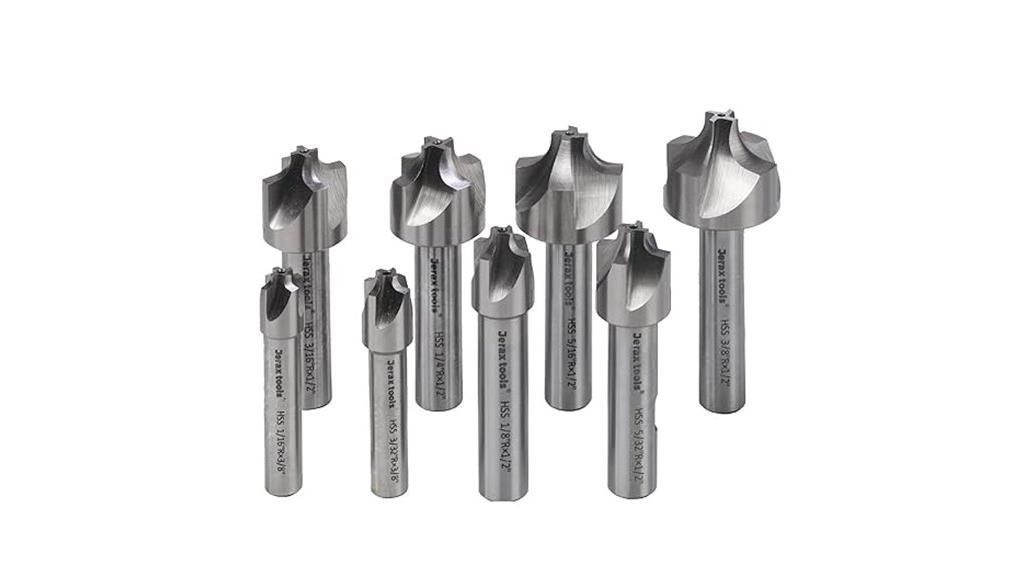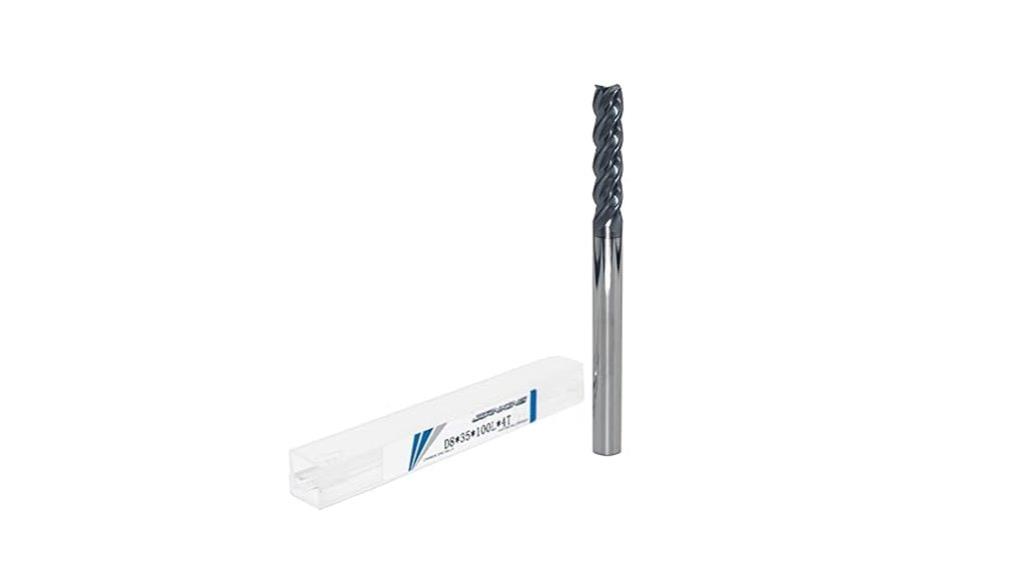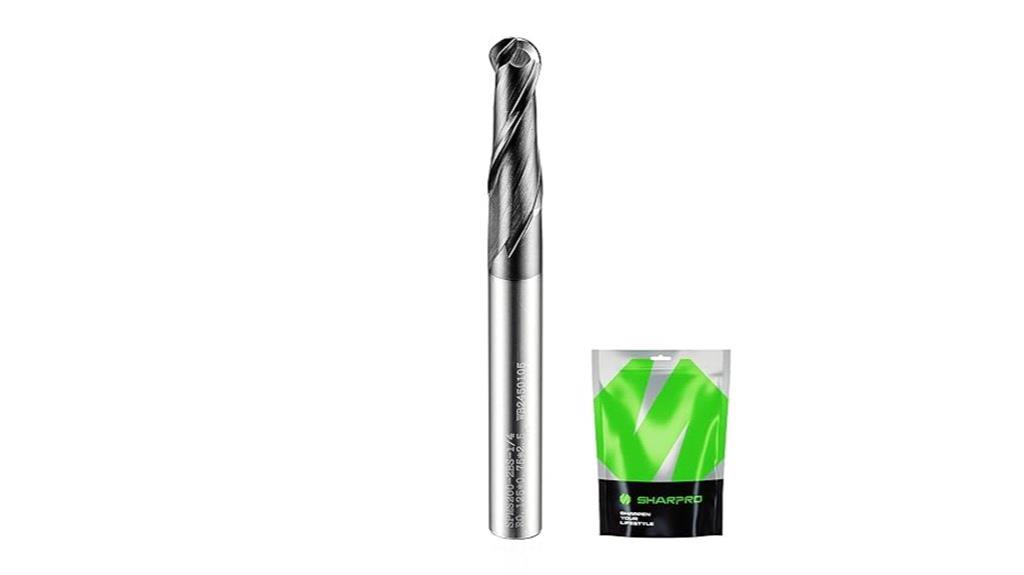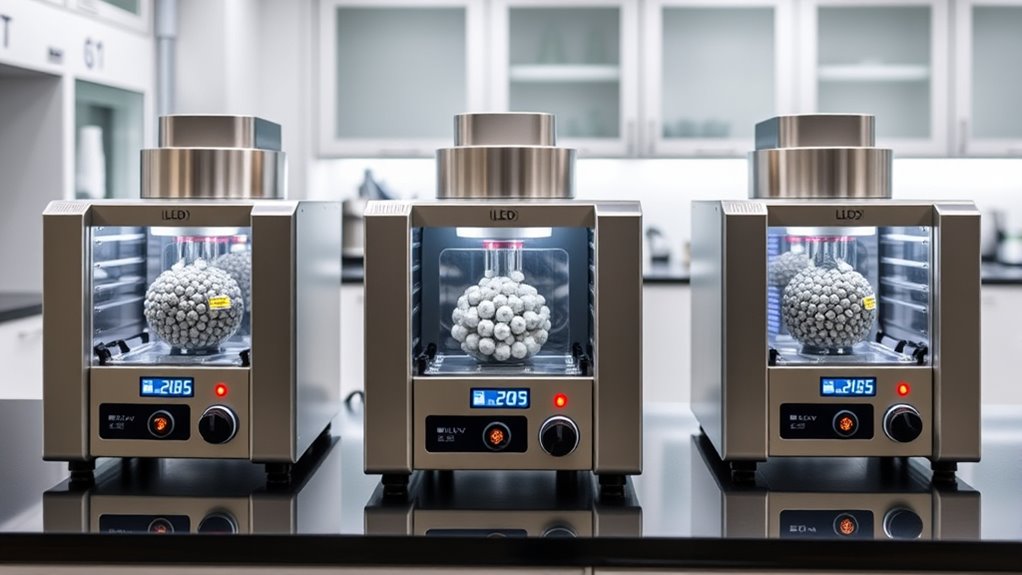If you’re looking for the top high-end bead mill homogenizers for 2025, I recommend models that combine powerful motors, precise speed controls, and durable materials that resist corrosion and wear. These units offer excellent sample disruption, consistent performance, and easy maintenance, making them ideal for demanding lab applications. Their ability to handle large capacities while minimizing noise and vibration sets them apart. Keep exploring how these features come together for superior results — there’s more to uncover ahead.
Key Takeaways
- Top homogenizers feature high power (20,000–30,000 RPM) with variable speed controls for precise sample disruption.
- Built with durable, chemical-resistant materials like stainless steel and tungsten carbide for longevity and reliability.
- Designed for easy maintenance with modular components, quick access, and robust sealing to ensure consistent performance.
- Capable of handling large sample volumes efficiently while minimizing noise and vibration for operator safety.
- Offer optimal value through energy efficiency, versatile applications, and durable construction for long-term laboratory use.
Corner Rounding End Mill Set, H.S.S. 8 Pcs

If you’re looking for a reliable tool to create precise, rounded edges on both ferrous and nonferrous materials, the Corner Rounding End Mill Set, H.S.S. 8 Pcs, is an excellent choice. Made from M2 HSS with 50% more Tungsten and 150% more Molybdenum than standard HSS, it offers superior durability and cutting performance. Its form-relieved design allows for repeated sharpening without losing shape, ensuring long-lasting use. The set includes various sizes from 1/16 to 3/8 inches, perfect for diverse projects. Packaged in a sturdy aluminum case, it guarantees easy storage, transport, and quick access whenever needed.
Best For: DIY enthusiasts and professional machinists seeking durable, precise corner rounding tools for both ferrous and nonferrous materials.
Pros:
- Made from high-quality M2 HSS with enhanced alloy composition for increased durability and cutting efficiency.
- ReSharpenable design allows repeated sharpening without changing the cutter’s shape, extending tool life.
- Includes a comprehensive set of sizes in a sturdy aluminum case for versatile applications and easy storage.
Cons:
- May be more expensive than standard HSS end mills due to premium materials.
- Requires proper handling and sharpening tools to maintain optimal performance.
- Not suitable for very high-speed machining or industrial heavy-duty applications.
8mm Carbide Square End Mill for Stainless Steel & Titanium (1-Pack)

The 8mm Carbide Square End Mill is engineered for professionals who demand exceptional performance when machining stainless steel and titanium alloys. Crafted from premium-grade carbide and CNC-ground, it delivers consistent precision. Its four-flute design offers a perfect balance of rigidity and efficient chip evacuation, while the spiral helix angle enhances chip removal and reduces cutting forces. Coated with advanced imported AP coating, it resists wear and heat buildup. This tool minimizes vibration and chatter, reducing chipping and tool breakage, while delivering a superior surface finish. Ideal for high-speed, high-temperature alloy machining, it ensures longer tool life and better machining efficiency in demanding applications.
Best For: professionals and machinists working with stainless steel, titanium alloys, and other high-temperature, hard-to-machine materials seeking precision, durability, and efficient chip removal.
Pros:
- Crafted from premium-grade carbide with CNC-ground precision ensuring consistent performance.
- Advanced imported AP coating provides excellent wear resistance and heat reduction.
- Unique variable helix structure minimizes vibration and chatter, enhancing stability and surface finish.
Cons:
- May be more expensive than standard end mills due to high-quality materials and coatings.
- Requires appropriate high-speed machining equipment to realize optimal performance.
- Limited to specific applications involving tough materials like stainless steel and titanium, less versatile for softer metals.
Carbide Ball Nose End Mill 2 Flute 1/4 Inch for Metalworking

Designed specifically for precision metalworking, the Carbide Ball Nose End Mill 2 Flute 1/4 Inch stands out with its high-accuracy, nearly perfect circular cutting edge. Its error margin of just -0.02mm guarantees smooth, precise curved surface machining. Made from durable carbide with an AlCrN coating, it withstands high temperatures during heavy cuts, maintaining stability and sharpness. Suitable for alloy steel, stainless steel, and cast iron, it excels in high-speed, deep cuts, and detailed 3D carving. Compatible with CNC machines, it delivers excellent performance, quiet operation, and reliable results, making it an essential tool for demanding metalworking projects.
Best For: high-precision metalworking professionals and hobbyists working on detailed 3D carving and deep cutting in steel and cast iron.
Pros:
- High-precision ball-nose edge with nearly perfect circular shape (-0.02mm error) for smooth curved surfaces
- Durable carbide construction with AlCrN coating for heat resistance and long-lasting sharpness
- Compatible with CNC machines, suitable for high-speed, deep cuts, and detailed machining tasks
Cons:
- May be more expensive than standard end mills due to high-quality materials and coating
- Requires careful handling to avoid chipping or damaging the precise cutting edge
- Not suitable for softer materials or less demanding applications
Factors to Consider When Choosing High‑End Bead Mill Homogenizers

When selecting a high-end bead mill homogenizer, I focus on key factors like power and performance to guarantee it handles my samples effectively. Material compatibility and homogenization speed are also vital to get consistent results without damaging samples. Additionally, I consider durability, ease of maintenance, and overall build quality to ensure the equipment remains reliable over time.
Power and Performance
Choosing a high-end bead mill homogenizer hinges considerably on its power and performance capabilities. Higher power levels enable me to efficiently disrupt tough or viscous samples, cutting down processing time markedly. Increased motor torque ensures consistent high-speed operation even under demanding sample conditions, resulting in uniform particle size reduction. Power output directly impacts my ability to generate fine, stable emulsions and suspensions in complex formulations. Many advanced homogenizers offer variable speed controls, allowing me to optimize energy input for different materials. Selecting a homogenizer with sufficient power guarantees reliable performance across various sample volumes and viscosities, minimizing equipment strain and reducing downtime. Ultimately, power and performance are essential for achieving precise, consistent results in diverse laboratory applications.
Material Compatibility
Material compatibility is essential when selecting a high-end bead mill homogenizer because using incompatible materials can lead to corrosion, contamination, or sample degradation. I always verify that the homogenizer’s components are chemically resistant to the substances I process, whether acids, bases, or solvents. The hardness and durability of the materials must match the abrasiveness of my samples to prevent wear and ensure longevity. Additionally, I consider the temperature range needed for my procedures, making sure the materials can withstand these conditions without deteriorating. For sensitive biological or chemical samples, I confirm that the construction materials don’t introduce unwanted particles or impurities. Proper material compatibility safeguards sample integrity and equipment performance, making it a critical factor in selecting the right homogenizer.
Homogenization Speed
Homogenization speed plays a pivotal role in determining the effectiveness and consistency of sample preparation. Higher speeds, typically between 20,000 and 30,000 RPM, enable thorough disruption of tough samples and finer particle size reduction. Many high-end bead mill homogenizers offer adjustable speed settings, allowing me to tailor the process for different sample types and viscosities. Maintaining consistent high speeds is essential for reproducible results, especially in applications demanding precision. However, I also need to be cautious of excessive speeds, which can generate heat, risking sample degradation and compromising integrity. Finding the right balance between speed and sample safety is key. Overall, speed control directly impacts homogenization quality, making it a critical factor when selecting a high-end homogenizer.
Durability and Build
Durability and build quality are essential factors when selecting a high-end bead mill homogenizer because they directly influence the equipment’s longevity and performance. I look for models constructed with tough materials like stainless steel or tungsten carbide, which resist wear from abrasive samples and repeated use. Precision-engineered shafts and sealed bearings ensure consistent operation and reduce the need for frequent maintenance. Robust sealing mechanisms protect internal components from contamination and harsh cleaning agents, extending the lifespan of the unit. A sturdy frame with vibration-dampening features offers stability during operation, preventing unnecessary wear. The overall design emphasizes longevity, with replaceable or sharpenable parts that don’t compromise the machine’s integrity, ensuring reliable performance over time.
Ease of Maintenance
Have you considered how easy it is to maintain a high-end bead mill homogenizer before making your choice? Maintenance should be straightforward, involving simple cleaning, disassembly, and access to essential parts. Regularly inspecting and replacing wear components like seals and bearings is critical to keep performance ideal and prevent downtime. Look for models that have accessible lubrication points, which make routine servicing easier and don’t require specialized tools. Modular designs also help, allowing quick repairs or part swaps, minimizing operational disruptions. Additionally, good documentation and manufacturer support are indispensable—they guide maintenance procedures and extend the lifespan of your equipment. Overall, choosing a homogenizer with user-friendly maintenance features saves time and effort, ensuring reliable performance over the long term.
Sample Volume Capacity
When selecting a high-end bead mill homogenizer, how much sample volume it can handle is a crucial factor to consider. The volume capacity determines the maximum amount of material processed in a single run, directly impacting throughput and efficiency. Larger sample volumes require more powerful machines with bigger chambers to guarantee uniform homogenization. Choosing a homogenizer with the right capacity helps prevent overloading, which can reduce sample quality and damage equipment. Matching the device’s volume capacity to your specific needs ensures maximum energy transfer and effective sample disruption. Additionally, the volume capacity influences the size and design of the homogenizer, affecting ease of use, cleaning, and integration into your workflow. Making this choice carefully enhances overall performance and longevity.
Noise and Vibration
Noise and vibration are critical factors to contemplate because they directly impact operator safety, comfort, and equipment performance. High-end bead mill homogenizers often feature vibration damping technology to keep noise levels low, enhancing the working environment. Excessive noise can signal imbalance or mechanical issues, which may lead to increased vibration and potential damage. Advanced homogenizers are engineered with precision to minimize vibration, resulting in quieter operation and better sample integrity. Lower noise and vibration levels also make prolonged use more comfortable and reduce fatigue. Additionally, monitoring these factors can help identify early signs of wear, allowing for preventive maintenance. This focus on noise and vibration not only ensures safer operation but also prolongs equipment lifespan, saving costs over time.
Cost and Value
While low noise and vibration levels contribute to safer and more comfortable operation, evaluating cost and value is equally important when selecting high-end bead mill homogenizers. These devices often have a higher initial price due to advanced features and quality materials, but they typically offer better long-term value through durability and consistent performance. Energy-efficient models can reduce operational costs over time, making them more cost-effective despite the upfront investment. The cost-to-performance ratio also matters; a more expensive homogenizer with faster processing and higher throughput can boost productivity and ROI. Additionally, premium units made with quality components tend to require fewer repairs, lowering maintenance expenses. Versatility is another key factor—machines that handle various sample types reduce the need for multiple devices, optimizing overall lab expenses.
Frequently Asked Questions
How Do High-End Bead Mill Homogenizers Improve Sample Consistency?
High-end bead mill homogenizers improve sample consistency by delivering uniform, powerful agitation that breaks down samples evenly. I notice they provide precise control over parameters like speed and time, ensuring each run is consistent. Their advanced design minimizes variability, so I get reliable, reproducible results every time. This consistency is essential for accurate analysis, making high-end homogenizers invaluable tools in my lab for achieving trustworthy data.
What Maintenance Is Required for Long-Term Optimal Performance?
To keep my high-end bead mill homogenizer performing at its best, I regularly clean the chamber and check for wear on the beads and seals. I also lubricate moving parts as recommended and follow the manufacturer’s maintenance schedule. It’s vital to monitor the motor and electronics for any irregularities and keep the unit stored properly when not in use. Consistent maintenance ensures precision and longevity in my experiments.
Are There Safety Features Specific to Advanced Homogenizer Models?
Yes, advanced homogenizer models come with specific safety features. I’ve seen models equipped with automatic shut-off systems that activate if the machine overheats or detects abnormal vibrations, preventing damage and injury. They also have secure lid locks to avoid accidental openings during operation and emergency stop buttons for quick shutdowns. These features give me peace of mind, ensuring safe and reliable use, especially during intensive or prolonged processing.
How Do Different Homogenizer Capacities Affect Processing Speed?
Did you know that a 10-liter homogenizer can process samples up to 50% faster than a 2-liter model? I’ve found that larger capacities typically mean increased processing speed, especially for bulk samples. However, they might require more power and cooling. When choosing, consider your sample volume and throughput needs, as bigger capacity can boost efficiency but also demands more from your equipment.
Can High-End Bead Mills Handle Both Small and Large Sample Volumes?
Yes, high-end bead mills can handle both small and large sample volumes effectively. I’ve found that top models offer adjustable capacity settings, allowing me to process tiny samples for detailed work or larger volumes for bulk preparation. They’re designed with versatility in mind, so whether I need precision for delicate experiments or power for bigger jobs, these homogenizers adapt seamlessly to my needs, ensuring consistent, reliable results every time.
Conclusion
Choosing the right high-end bead mill homogenizer is like finding a trusted partner in a dance—it needs to be powerful, precise, and reliable. With the top options I’ve shared, you’ll be well-equipped for any demanding task in 2025. Remember, the right tool can turn complex processes into smooth operations, just like a well-choreographed routine. So, pick your perfect match, and watch your work shine with clarity and confidence.









